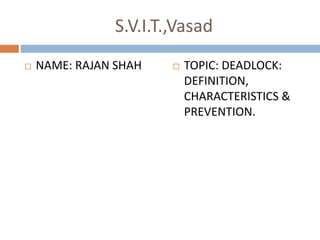
Deadlock- Operating System
- 1. S.V.I.T.,Vasad NAME: RAJAN SHAH TOPIC: DEADLOCK: DEFINITION, CHARACTERISTICS & PREVENTION.
- 2. DEADLOCK Definition: A deadlock is a situation in which two computer programs sharing the same resource are effectively preventing each other from accessing the resource, resulting in both programs ceasing to function. The reason, why earliest computer OS ran only one program at a time. A set of processes is deadlocked if each process in the set is waiting for an event that only another process can trigger.
- 3. Continue... As all the processes in the set are waiting for an another process to trigger an event that could wake up any of the other members of the set, all the processes would wait for ever. None of the processes can run, none of them can release any resource, and thus none can be awakened. The no. of processes and the no. and kind of resources processed and requested are unimp.. This kind of request holds for any kind of resource and is called Resource Deadlock.
- 4. Characteristics Of Deadlock A deadlock situation can arise if the following four conditions hold simultaneously in a system: 1. Mutual Exclusion 2. Hold & Wait 3. No Pre-emption 4. Circular wait.
- 5. Prevention Techniques The methods to prevent the Deadlock are: 1. Attacking the Mutual Exclusion Condition. 2. Attacking the Hold & Wait Condition. 3. Attacking the No Pre-emption Condition. 4. Attacking the Circular Wait Condition.
- 6. Attacking the Mutual Exclusion Condition Mutual Exclusion: For two processes, if any one process is accessing the common resource then the another process is excluded from accessing the resource. Thus, each resource is either currently allocated to exactly one process or it is available for other process to access it. Two processes can’t simultaneously access the common resource.
- 7. Example It is clear that by allowing two processes to write on the printer simultaneously will lead to chaos. Actually, the only process which requests the physical printer is the printer daemon. Printer daemon never requests any other resource, so the deadlock can be eliminated and also it prints only after the complete o/p file is available. But this could in itself lead to deadlock for two processes having finished their part, but not all, of their o/p, and can’t continue. Thus, avoiding to assign a resource unless not absolutely necessary and try to make less processes request for the resource.
- 8. Attacking the Hold & Wait Condition Hold and Wait: In this scenario, processes currently holding resource can request new resource to complete its task. If the process requests all the resources before starting the execution, deadlocks can be eliminated. I.E. if everything is available, process will be allocated whatever it needs and can run to completion. Whereas, if one or more of the requested resource is/are busy, then nothing will be allocated and the process would just wait for the resource to become free and enter the critical region. The problem that how many resources does a process may need can’t be known until it has started running.
- 9. Example Consider a process, that reads data from an i/p tape, analyzes it for an hour, and then writes an o/p tape as well as plotting the results. Thus, if all resources are requested in adv, the process will tie up the o/p tape and the plotter for an hour. Thus, this method wastes the resources as for an hour no other process would be able to use the plotter and the o/p tape.
- 10. Attacking the No Pre-emption Condition No Pre-emption: Once a process holds a resource, it can’t be taken away by another process or the kernel and resource can only be voluntarily released by the process. Example: if a process is assigned a printer and is in the middle of printing its output, forcibly taking away the printer because the plotter needed isn’t available is not possible. Thus, a resource can be used only if the process holding it, releases it voluntarily.
- 11. Attacking the Circular Wait Condition Circular wait: Each process is waiting to obtain a resource which is held by another process. The circular wait can be eliminated by a rule that if a process is holding a resource at the moment then it can’t request for other resource, and if it wants to access the other resource then it must release the first one. Another way to avoid the circular wait is to provide a global numbering of all the resources. A process can request whenever it wants, but all the request must be made in numerical order.
- 12. Example Consider the following resources numbered as below: 1. Image setter 2. Scanner 3. Plotter 4. Tape-Drive 5. CD-ROM drive. A process may request first a printer and then a tape drive, but it can’t request first a plotter and then a printer.
- 13. Example Here, if A requests for j ; i>j, then A is not allowed to request j because that is lower than what it already has. Similarly, if B requests for i; i<j, then B is not allowed to request for i. Thus, either way deadlock is not possible. A i B j
- 14. THANK YOU
